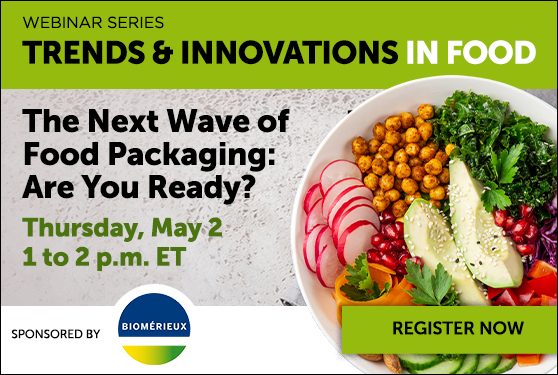
Food in Canada is thrilled to present our annual webinar series on “Trends and Innovations in Food.” On May 2, we’ll discuss the challenges with balancing food safety needs and sustainability in food packaging.
The Next Wave of Food Packaging: Are You Ready?
The federal government has made elimination of plastic from food packaging a priority. While it’s important to reduce plastic food packaging and divert them from landfills, there are no easy solutions. However, the food industry has the responsibility of meeting consumer desires for environmentally friendly packaging and more sustainable food that are also safe and delicious. How does the industry balance these needs? Change is coming, and we must be ready for it.
Join industry experts Martin Gooch, PhD, CEO, Value Chain Management International (VCMI); Sarah Acchione, Procurement Manager, Italpasta; and Leonardo Giglio, Optimist & CEO, Tempo Flexible Packaging, as they delve into complex world of food packaging.
Speakers
Martin Gooch, PhD, CEO, Value Chain Management International

Dr. Martin Gooch is co-founder and CEO of Value Chain Management International (VCMI), a global consulting company that helps businesses, primarily in the agri-food and seafood industries, enhance their long-term profitability and environmental sustainability. Packaging related analysis and innovations completed by the VCMI team in North America and Europe include optimizing food packaging and merchandizing options from environmental, economic and consumer perspectives. Martin holds a PhD and master’s degree in agri-food management, a bachelor’s degree in international business, along with qualifications in farm management and agricultural production. In 2013, Martin received Bayer’s “Outstanding Canadian” award for his contribution to “Food Chain Partnerships.” In 2017, the Ontario Produce Marketing Association awarded Martin the Cory Clack-Streef “Produce Industry Person of the Year.” Martin is a member of the PAC Global Leadership Council.
Sarah Acchione, Procurement Manager, Italpasta

Sarah Acchione is the Procurement Manager at Italpasta, which was founded in 1989. A passion and love for food is the driving force behind the quality products it produces. Inspired by Italy but proudly 100 per cent Canadian owned and operated, Italpasta pasta is made with 100 per cent Canadian wheat. Sarah joined Italpasta’s sales department in 2007 and became a national account executive in 2012. In 2022, Sarah transitioned into the role of Procurement Manager. Sarah is also serving as a member on the Board of Directors for Food and Beverage Ontario from 2017-2020, returning in 2023.
Leonardo Giglio, Optimist & CEO, Tempo Flexible Packaging

Leonardo (Len) Giglio has been the Optimist & CEO of Tempo Flexible Packaging since January 2021, working alongside his sister, COO Lee-Anne Giglio. Having inherited his passion for innovation from his father, co-founder and president, Joseph Giglio, Len is a driving force behind Tempo’s continuous improvement mindset. He is dedicated to rethinking flexible packaging in a sustainable manner and driving positive impact not just within the organization, but also across the team, partners, and community. Since joining Team Tempo in 2007, Len has held various business development and marketing roles– gaining insight into the practical and technical aspects of packaging production and understanding the specific needs of retailers and brand owners. This wealth of knowledge has been instrumental in the development of Tempo’s award-winning, recycle-ready solution line – HarmonyPack. An outspoken advocate for eliminating plastic waste and better end-of-life options for flexible plastics, Len serves on the advisory board of the Canada Plastics Pact.
Past Sessions
We kicked off the Trends and Innovations in Food webinar series on March 5 with a discussion on “The Ozempic Effect” and the impact of GLP-1 weight loss drugs on food consumption. Click here for a summary report. To watch the full webinar, visit https://www.foodincanada.com/webinar-series-session-1.
On April 11, we explored cutting-edge advancements in artificial intelligence (AI) and its impact on F&B processing. To watch the full webinar, visit https://www.foodincanada.com/webinar-series-session-2.
This webinar is sponsored by is sponsored by BioMérieux. It’ll be moderated by Food in Canada’s editor Nithya Caleb.
Watch Webinar NowPrint this page
